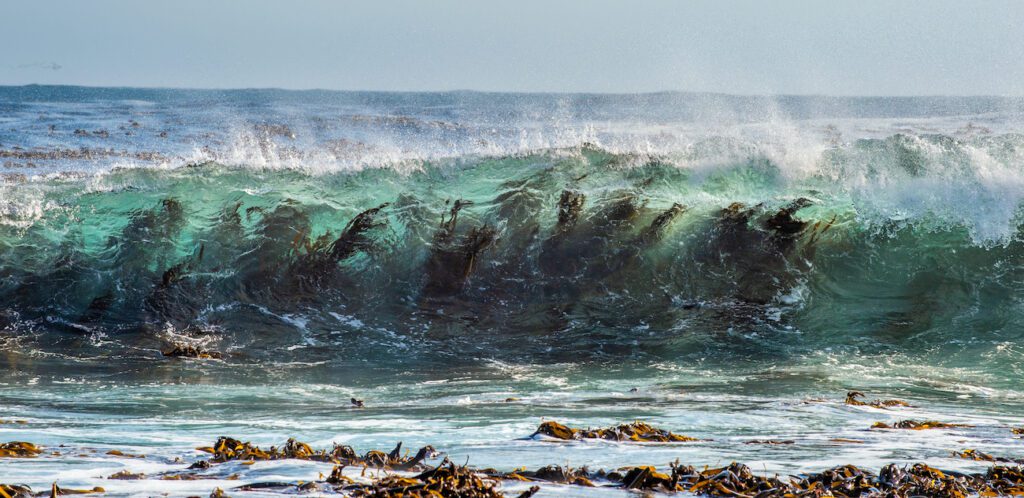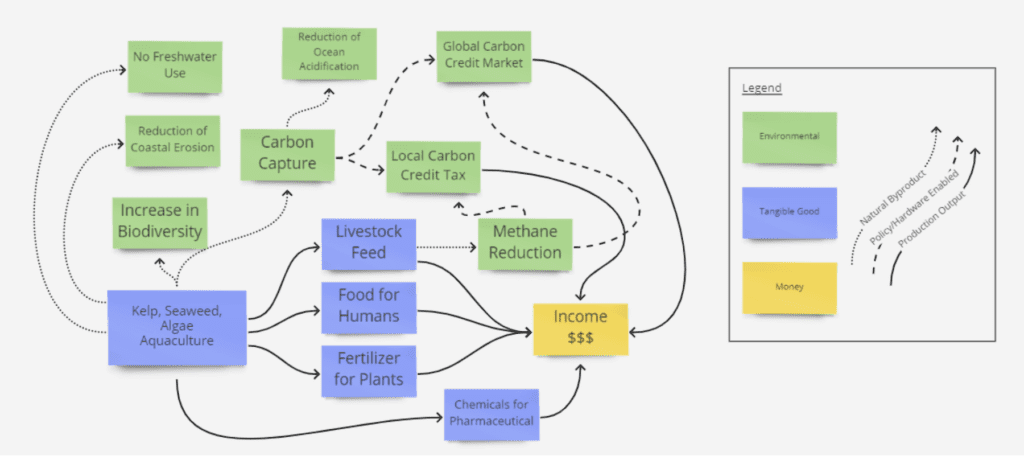After listening to a podcast about Kelp Farming, for the Climate on HOW TO SAVE A PLANET and watching this great Seaweed Farming video series, I have been obsessed with the idea of macroalgae/kelp/seaweed farming because it can help combat climate change. The podcast and the video series have been excellent in helping me combat my own climate anxiety in the face of an increasingly bleak climate future.
For general humanity’s sake, there is hope to be found in several companies that are already working on this. Running Tide is a global ocean health company whose goal is to curb climate change by leveraging the carbon-capturing capability of macroalgae (colloquially known as seaweed). GreenWave is a non-profit that is focused on the development of regenerative farming techniques for aquaculture. Their efforts against global warming extends to leveraging the increasing number of seaweed byproducts to establish more sustainable global agriculture production and foodstuff alternatives.

If you were wondering, seaweed does work like any other photosynthetic organism: carbon and photons (sunlight) go in and mass (sugar) comes out. This is a classic large-scale example of the net negative carbon sinking process that has been typically associated with the Amazon Rainforest or at least was until recently due to deforestation and fires which have started to emit more CO2 than it can sink.
Currently the oceans cover two-thirds of the Earth’s surface which constitutes a massive, natural carbon capture system. Seaweeds absorb carbon and can eventually sink to the ocean floor, where the immense pressure keeps the carbon sequestered for thousands of years. For Running Tide and organizations alike, their methodology is to accelerate/guarantee this naturally occurring process – the more seaweed that can sink past the halocline, the better. It certainly seems possible that this could go a long way towards limiting climate change, but as with every new method/technology, there are plenty of problems to consider and work through.
A Multitude of Potential Benefits
In addition to slowing or even helping reverse climate change, engineered-seaweed farming systems have reinvigorated coastal communities by shifting their economies away from dependence on dying fishing industries. While doing this research, I have realized how important it is to acknowledge that while the cultivation of seaweed is novel to the modern western world, many civilizations have practiced aquafarming for centuries and we are behind the curve.
Perhaps given the previous points about reinvigorating coastal communities and this practice of aquaculture, it may be obvious to say but the intentional farming of marine plants can be monetized through the sale of both crops and hopefully at some point be awarded carbon credits from an accredited institution. Instead of using seaweed exclusively as carbon sinks, harvested seaweed can be used to feed people and livestock or be a natural fertilizer for traditional crops. Also, iodine extracted from seaweed can be sold to the medical industry. As mentioned previously, GreenWave has a goal to establish sustainable global agriculture production and foodstuff alternatives. They are currently implementing programs to accelerate this approach at multiple levels in the food and pharmaceutical industries.

At a minimum, the alternative options provided by the various seaweed-based products are unlikely to be a bad thing. The uncertainty in the current global food supply chain only stands to benefit from additional food sources.
The good news is that help is already here for individuals and companies that are interested in pursuing growing seaweed as a full-time job or as an alternative aquaculture crop. GreenWave is also leading the charge on that front with a 10-year goal to “provide training, tools, and support to a baseline of 10,000 regenerative ocean farmers to catalyze the planting of 1 million acres and yield meaningful economic and climate impacts,” according to their website.
Optimization Is Challenging But Essential
The shift from viewing seaweed as purely for consumption to positioning seaweed as a carbon sink is a relatively new concept. In my opinion, any new climate solutions like this should have the mechanisms to provide real-time feedback for one primary reason: there needs to be transparency on the true effectiveness of a climate tech solution. If it turns out that the solution is not working, there is no point in continuing because doing so would only add to the problem. Assuming the mass production of seaweed does work, then we would need specific data and information to effectively market it to the public.
In the case of engineered-seaweed farming systems, building systems and sensors that can withstand the wildly harsh and ever-changing ocean environment while generating a comprehensive set of data to optimize production is an exciting challenge for these undersea carbon sequestration efforts. While the potential benefits of seaweed cultivation are abundant, so too are the challenges in building increasingly efficient and scalable aquaculture systems. Measuring carbon capture in natural organisms is a challenge on land and it only gets harder in the ocean. But by continuing to monitor the seaweed’s growth, it would optimize the farming systems’ performance which would then lead to the generation of traceable & verifiable carbon credits for the global market.
The rapid growth in this sector, including platforms like Seatech’s ORCA-SP™ that allow for industrial-scale cultivation, are generating optimism about the path ahead. Many factors will contribute to the optimization of these systems such as monitoring sunlight at every depth of the system, measuring water nutrient composition, providing live estimates on growline harvest weight, and measuring relative dissolved CO2 to name a few.
If we’re unable to reverse climate change at the pace we need to, at least we will have some beautiful kelp forests to look at when our coastal cities end up underwater.
